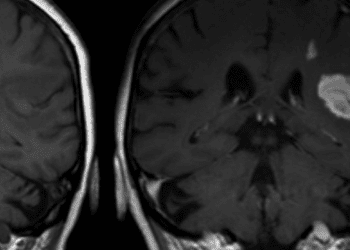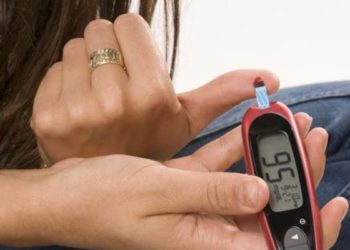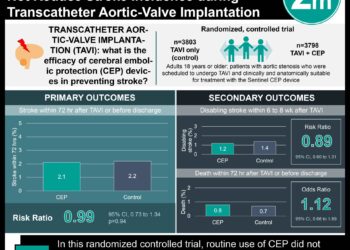2 Minute Medicine Rewind October 16, 2023
Health Insurance and Differences in Infant Mortality Rates in the US
1. In this cohort study, patients with Medicaid insurance coverage had higher rates of infant mortality compared to those with private insurance.
Evidence rating level: 2 (Good)
The infant mortality rate (IMR) in the United States is one of the highest among developed countries. Researchers aimed to determine whether access to private health insurance compared to Medicaid insurance has an impact on the IMR. Medicaid Insurance is available to those with a gross family income within 138% of the federal poverty level. Data were collected from the Centers for Disease Control and Prevention birth and infant death records database, 2017 to 2020. Infants were excluded from the study if they were born with congenital anomalies, born outside of 20 to 42 weeks of gestational age, or if their mothers had self-pay insurance status. Of 13,562,526 hospital-born infants in the study, 54% were covered with private insurance, and 46% were covered with Medicaid. Researchers adjusted for several confounding variables including race, infant sex, multiple gestations, several maternal pregnancy risk factors, education level, and tobacco use. The IMR was lower for those with private insurance compared to Medicaid insurance, (2.75 vs 5.30 deaths per 1000 live births; adjusted relative risk [aRR], 0.81; 95% CI, 0.69-0.95; P = .009). The post-neonatal mortality rate was similarly lower for those with private insurance compared to Medicaid insurance, (0.81 vs 2.41 deaths per 1000 births; aRR, 0.57; 95% CI, 0.47-0.68; P < .001). Additionally, private insurance was associated with a significantly reduced risk of low birth weight infants, breech delivery, and preterm birth, and significantly greater use of prenatal care in early pregnancy. A limitation of this study is that additional confounding variables were not adjusted for, particularly prenatal alcohol and recreational drug use. It is also important to consider that insurance status is directly related to socioeconomic status, and therefore cannot be treated as a true independent variable. Overall, this study demonstrates that those giving birth in the United States with Medicaid insurance coverage have higher rates of infant mortality compared to those with private coverage. Future work may examine whether there are opportunities to improve prenatal, intrapartum, and postnatal care for those in the US with Medicaid coverage.
1. In this randomized controlled trial, early compared to late blood pressure management following an acute ischemic stroke did not impact the risk of death or functional dependency at 90 days.
Evidence rating level: 1 (Excellent)
Researchers aimed to determine whether early treatment of hypertension after an ischemic stroke impacts the risk of death or functional dependency (modified Rankin scale score ≥3). 4810 participants were included in the study, which was conducted in China between June 13, 2018, and July 10, 2022. Participants included those over age 40 who had suffered an ischemic stroke and did not receive antithrombolytic treatment. All participants were hypertensive on presentation, with systolic blood pressure (SBP) between 140 and 220 mmHg. 2413 participants were randomized to an early treatment group and received antihypertensive treatment within 24 hours of an ischemic stroke, with the goal of achieving blood pressure below 140/90 by day 7. The remaining 2397 participants were randomized into the delayed treatment group and received antihypertensive treatment starting on day 8, with the same blood pressure target of <140/90. On day 7, the mean SBP was 139.1 mmHg in the early treatment group, compared to 150.9 mmHg in the delayed treatment group (P <.001). 90 days post-stoke, there was no significant difference in the risk of death or functional dependency between the two groups; 12.0% in the early treatment group, compared to 10.5% in the delayed treatment group, P = .08. There was also no difference in the risk of recurrent strokes between these two groups. A limitation of this study is that neither participants nor physicians were blinded to the treatment assignments. As well, the majority of participants in this study had mild to moderate stroke symptoms; therefore, the data is not generalizable to stroke patients with more severe symptoms. Overall, this study demonstrates that early compared to late blood pressure management following an acute ischemic stroke does not impact the risk of death or functional dependency at 90 days.
1. This single-blinded, phase 2 randomized clinical trial found that intraventricular lavage had a significantly higher rate of serious adverse events (SAE) compared with external ventricular drain (EVD) treatment.
Evidence Rating Level: 1 (Excellent)
IVH—characterized by bleeding within the brain’s ventricles—is typically treated with supportive care and passive drainage using an EVD. A new intraventricular lavage technology, called IRRAflow, utilizes an active dual-lumen catheter for precise ventricular saline perfusion, aiming to speed up IVH washout and prevent complications. This single-blinded, phase 2 randomized clinical trial aims to investigate the safety and efficacy of intraventricular lavage compared with standard EVD treatment of IVH. 21 participants (median [IQR] age, 67 [59-82] years; 66% male) were randomly assigned in a 1:1 ratio to receive either intraventricular lavage (intervention) or standard EVD (control). They were blinded to their respective treatments, with 11 participants in the intervention group and 10 in the control group. The rate of catheter occlusions (primary outcome) was significantly higher in the intervention group compared with the EVD group (hazard ratio 4.4 [95% CI, 0.6-31.2]; P = .14; meeting the prespecified α = .20). The procedure time for catheter placement was significantly longer for the intervention group compared with the control group (median [IQR] time, 53.5 [33-75] minutes vs 12 [4-20] minutes; P < .001). The intervention group required significantly more time for catheter placement compared to the control group (median [IQR] time, 53.5 [33-75] minutes vs 12 [4-20] minutes; P < .001). Based on an interim analysis of the first 20 participants, the intervention group faced a significantly higher risk of experiencing at least 1SAE (absolute risk difference 0.43, 95% CI, 0.06-0.81; P = .04). Consequently, the study was terminated early. In terms of treatment efficacy, the hematoma clearance rate did not differ significantly between the intervention and control groups (P = .64). These findings suggest that intraventricular lavage technology has a higher risk of SAEs under the investigated conditions, emphasizing the importance of caution and technology adaptations to ensure patient safety.
1. This cohort study of pediatric solid organ transplant (SOT) patients found that the measles-mumps-rubella (MMR) and varicella-zoster virus (VZV) vaccines were both safe and efficacious, with low risk for serious adverse events and infection.
Evidence Rating Level: 2 (Good)
In SOT recipients, no recommendation to date has supported the use of live vaccines (MMR and VZV) due to theoretical risk of infection. This immunocompromised population, particularly the pediatric subgroup, is left susceptible to these life-threatening conditions and faces unique challenges in safeguarding their own health. With the rising rates of measles, mumps, and varicella worldwide, there is a role for determining whether these vaccines are able to provide robust protection without compromising safety in this vulnerable group. The current cohort study sought to explore this very topic. A total of 281 kidney or liver transplant patients (270 liver, 9 kidney, 2 liver-kidney recipients) who had not fully completed their MMR and VZV vaccine series and/or displayed nonprotective serum antibodies were selected. Most patients were receiving low level immunosuppression (although some were receiving more extensive immunosuppression), were more than 1 year post transplant and two months post rejection, and were assessed to have age-appropriate lymphocyte counts. Patients received between 1-3 doses of MMR, VZV, or both vaccines. In posttransplant participants, when tested for protective antibodies between one to three months post-vaccination, 72% developed protective antibodies for VZV, 86% developed protective antibodies for measles, and 99% developed protective antibodies for mumps. One-year post-vaccination, protective antibodies were maintained in the majority of recipients. Following VZV vaccination, 5 of the 217 children (2%; all receiving moderate to high immunosuppression at the time) developed clinical varicella more than one-week post-vaccine, all with resolution within 1 week (three of the five required antiviral therapy). No measles or rubella cases were recorded, and although one patient experienced transient nontender subauricular lymph node swelling without other symptoms 3 weeks after MMR vaccination, this resolved without intervention. With respect to safety, there were no serious adverse events recorded. The results above indicate that, in this study, live vaccinations post-transplant were both safe and immunogenic. While these preliminary results are promising and could signal a shift in recommendations for live vaccination in this population, further studies should be repeated and elucidate the associations between pretransplant antibody levels/vaccination and findings post-transplant. Other types of organ transplant should also be considered in future studies.
1. Fotagliptin, a novel dipeptidyl peptidase-4 inhibitor (DPP4-i), was found to be noninferior to alogliptin and significantly more effective than placebo in meeting hemoglobin A1c (HbA1c) targets and reducing fasting blood glucose (FBG) in treatment-naive uncontrolled type 2 diabetes mellitus (T2DM) patients.
2. Fotagliptin was also found to be safe and well tolerated. Its use also resulted in significantly improved beta-cell function and fasting c-peptide concentration.
Evidence Rating Level: 1 (Excellent)
T2DM is among the most burdensome of communicable diseases with a rising prevalence worldwide. DPP4-is exert glycemic control by inhibiting the rapid degradation of incretin hormones and glucagon secretion, but under most guidelines, they are currently recommended as a second-line pharmacotherapy for glycemic control. The current randomized, multicenter, double-blind, and placebo-controlled approach recruited treatment-naive patients with uncontrolled T2DM (defined as HbA1c of 7.5 to 10.5% and fasting blood glucose of ≤ 13.9 mmol/L) in order to assess the efficacy and safety profile of a novel highly selective 12 mg once daily DPP4-i, fotagliptin. After a 4-week exercise and diet run-in period, patients were randomized to receive either fotagliptin (n = 230), alogliptin (n = 113), or a placebo (n = 115) for 24 weeks double-blind, followed by another 28 weeks of open-label treatment. Eighty-five percent of patients remained in this trial to its 52-week completion. At 24 weeks, fotagliptin was noninferior to alogliptin (p = .854), and both resulted in significant reductions in HbA1c percentages compared to placebo (ps < .0001; decreases of 0.7%, 0.72%, and 0.26% for fotogliptin, alogliptin, and placebo, respectively). Over 20% of patients receiving fotagliptin reached a HbA1C of ≤ 6.5% (p = .0003), and 37% were found to have HbA1cs of ≤ 7.0% (p < .0001). There was also a significant reduction in FBG after 24 weeks for both fotagliptin and alogliptin participants (p < .05). However, weight did not differ significantly between the groups and less than 1kg of weight loss was found in any group over the course of the study. Beta-cell function from baseline to week 24 showed significant improvements in patients receiving DPP4-is, and fotagliptin was associated with significantly improved fasting c-peptide concentration. With respect to safety, two fotagliptin participants experienced mild hypoglycemia over the course of the study, but both fotagliptin and alogliptin were found to be well tolerated. No deaths were reported, and all adverse events occurred in 4% of participants or fewer (3.1% for fotagliptin group, 3.6% for alogliptin group and 6.2% for placebo group). No episodes of pancreatitis occurred during the study period, although minimal increases in amylase and lipase levels were noted in weeks 4 to 24 for the treatment groups. Future studies surrounding fotagliptin should be repeated for longer durations in order to assess for potential cardiovascular protection, as well as its efficacy when used in conjunction with first-line therapy, metformin.
Image: PD
©2023 2 Minute Medicine, Inc. All rights reserved. No works may be reproduced without expressed written consent from 2 Minute Medicine, Inc. Inquire about licensing here. No article should be construed as medical advice and is not intended as such by the authors or by 2 Minute Medicine, Inc.







